2025 Ford E-Transit Courier Review
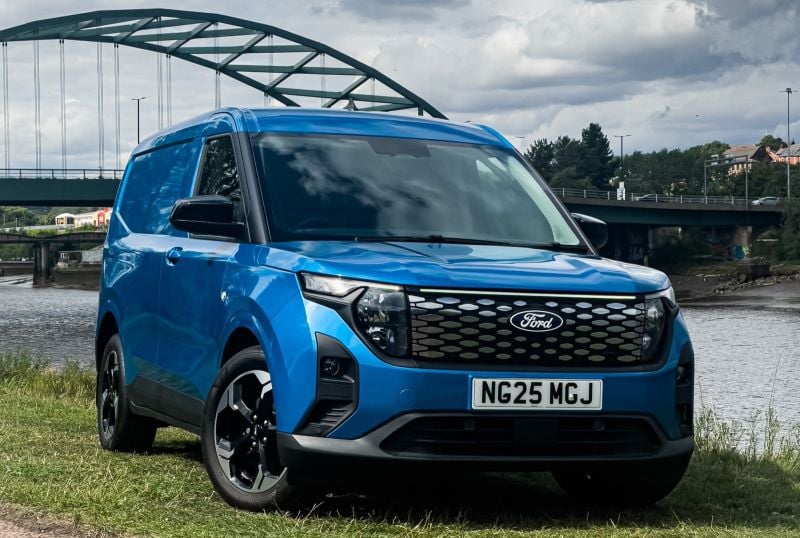
When it comes to vans, logic dictates that ‘bigger is better’ – so where does that leave the Ford E-Transit Courier, one of the smallest small vans on the market? Vansdirect hits the road to find out...
Van as Tested: Ford E-Transit Courier Limited
Power: 43kWh Electric
Supplied: Vertu Ford Newcastle
While it may be the ‘baby’ of the Transit family, to dismiss the E-Transit Courier for its size relative to its Connect, Custom and Transit siblings would be to miss the point entirely.
Indeed, what the E-Transit Courier might lose in physical dimensions and payload capacity to rivals like the Citroen Berlingo and Renault Kangoo on paper, it aims to recoup by being superior in other key areas.
Moreover, this is the E-Transit Courier, or put another way, the electric version of the Ford Transit Courier. It serves its own purpose in Ford’s dual-pronged small van offensive since the larger Connect’s greenest trim is limited to a Plug-in Hybrid (PHEV) model.
Pitched as a taut city slicker with penny-pinching running costs, the Ford E-Transit Courier might be a ‘small’ small van (relatively speaking) but could it still be all the van you’ll ever need?

Where Does the Ford E-Transit Courier Fit into the Ford Transit Range?
It has been two decades since Ford opted to spin the historic Transit name into what is effectively its own commercial vehicle sub-brand.
First came the Ford Transit Connect in 2002, followed by the Ford Transit Custom to differentiate it from the largest Ford Transit (retaining its original title) before the range was completed with the Ford Transit Courier in 2014.
Slotting in as the entry-point into the Transit range, the first-generation Courier was pitched primarily for city-based van drivers where the compact dimensions and small capacity engine range made it well suited to urban jaunts and light deliveries.
The second-generation Ford Transit Courier, however, sees a substantial growth in dimensions – an extra 200mm in wheelbase/length, 90mm in height – to assure a more spacious load area, without compromising its nimbleness through city lanes.
It also gained much sharper styling with the curved silhouette of its predecessor being replaced by an SUV-inspired utilitarian design complete with sharp edges and a bluff front-end.
Even with the growth in size, the Transit Courier is still the smallest Transit in the range, being 4.3m in length, whereas the Transit Connect is 4.4m. It should be noted though that the E-Transit Courier is available in just a single wheelbase option, whereas the Connect can be had in a LWB configuration.
Ford E-Transit Courier – The Direct Verdict
While you might question the wisdom of having two small vans – the Courier and Connect – battling in the same market space, the reality is the E-Transit Courier, with its frugal EV powertrain and sharp dynamics could be described as more of a ‘city van’. Within this context, the Ford E-Transit Courier fulfils its brief with aplomb, being easy-to-drive, easy to manoeuvre and – ultimately - easy to like. And don’t be fooled by those compact dimensions, the E-Transit Courier is deceptively practical inside.
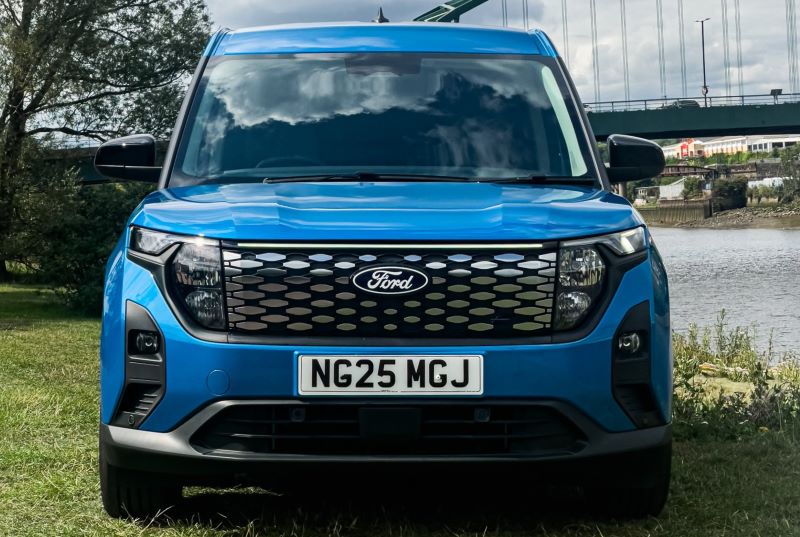
Lease the Ford E-Transit Courier if...
- You need a nimble and easy-to-drive small van
- You drive mostly in urban environments
- You want to reduce your running costs significantly
- Your business deals in rapid-service deliveries
Lease the Ford E-Transit Courier with Vansdirect
Leasing a new Ford E-Transit Courier van with Vansdirect has never been easier or better value.
Get the right van at the right deal, right now with the best Ford Transit Courier van leasing deals, including petrol, diesel and electric E-Transit Courier models.
Speak to our expert team today and you could be driving a new van for less than you think, sooner than you thought.
Ford E-Transit Courier: Load Space, Dimensions & Practicality
While there is no mistaking that the Courier is positioned below the Connect in the Transit range, there is surprisingly little to choose between the two models in terms of outright size.
This represents a change of tact for Ford, who took the opportunity between the first and second-generation Transit Courier to stretch the dimensions to just shy of the current Connect.
The difference between the Ford E-Transit Courier and its predecessor is very evident from the outset. The softer outline has given way to squared-off edges wherever you look, while the straightened roofline and bluff ends serve to maximise interior space.
In terms of external dimensions, the E-Transit Courier is just 63mm shorter in length than a Citroen Berlingo and a mere 14mm lower in height.
The 2.9 cubic metre load bay is accessed via 60:40 asymmetric rear-doors that can both be opened 90-degrees, or in the case of the smaller door, a full 180-degrees.
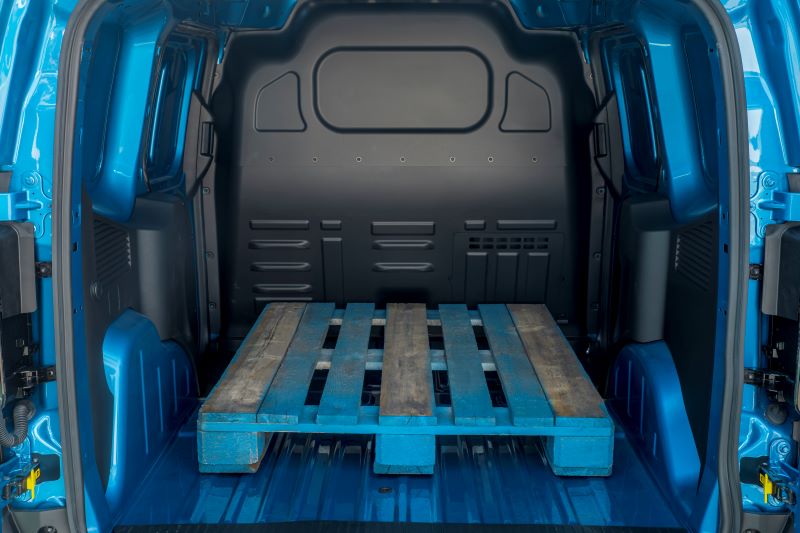
The cargo bay itself is neatly packaged with slender wheelarch housings taking up precious little space and a shaped plastic bulkhead that maximises the floor space. Moreover, if you need some additional length, a bulkhead hatch increases the floor from 1802mm to 2661mm, while total cargo room rises from 2.9 to 3.0 cubic metres.
The latest Transit Courier does also come with a side sliding door, while the cargo bay is comfortably large enough to accommodate a Euro pallet.
| Ford E-Transit Courier | |
| Length | 4337mm |
| Height | 1850mm |
| Wheelbase | 2692mm |
| Load Length | 1802mm |
| Load Width | 1535mm |
| Load Height | 1262mm |
| Load Volume | 2.9 cu m |
| Max Payload | 683-698kg |
| Braked Towing Capacity | 750kg |
| Gross Vehicle Weight | 2250kg |
Ford E-Transit Courier: Weights, Loads & Towing
Whereas it is commonplace for electric vans to demand a compromise in terms of payload capacity, the E-Transit Courier is more generous than its petrol and diesel counterparts in this area.
Indeed, while all versions of the Transit Courier exceed 600kg for payload, the E-Transit Courier Trend and Limited top the range with 698kg and 683kg respectively.
This puts the E-Transit Courier within range of other diesel or petrol-powered small vans, while Ford says it is possible to specify dual rate springs to increase the payload capacity to 845kg, which is just shy of the best in class.
Petrol and diesel Transit Couriers can handle larger towing capacities (between 1000 and 1100kg), whereas the E-Transit Courier is set at 750kg.
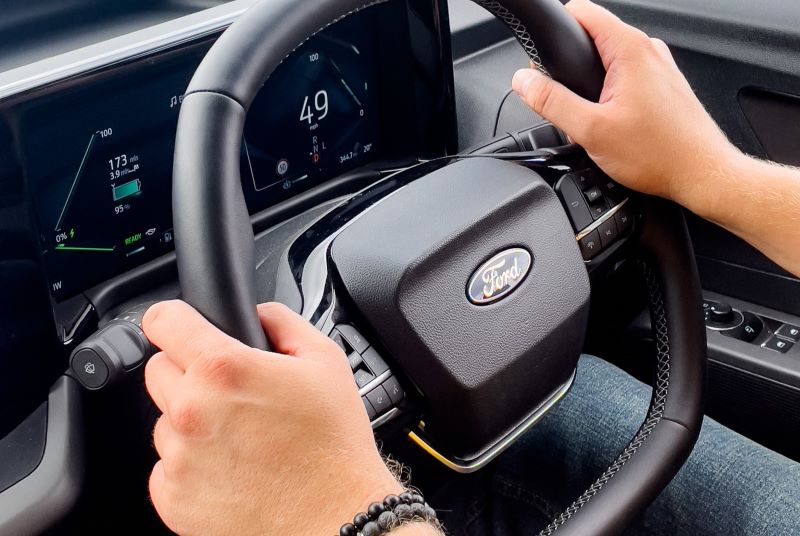
Ford E-Transit Courier: Range, Charging & Running Costs
Since it is likely we will have to wait for the next generation Transit Connect to get a full BEV (battery electric vehicle) version, the Ford E-Transit Courier therefore satisfies the brief as Ford’s only electric small van.
With 43kWh on tap, the E-Transit Courier all-but-matches the equivalent Renault Kangoo E-Tech (44kWh) and Nissan Townstar EV (45kWh) but gives away some capacity to the Berlingo and co. (52kWh).
It also sacrifices some range with the manufacturer quoting 181 miles on a combined cycle, though our test car showed 186 miles on the dashboard when it was fully charged.
Driven on a multitude of roads – including city streets, residential areas, motorways and country roads – the E-Transit Courier doesn’t deviate far from the anticipated range drop, particularly in Eco mode which clips the responsiveness of the accelerator to use less power.
That’s not to say the E-Transit Courier ever lacked responsiveness, proving quick off the mark and making light work of inclines even in its most conservative setting. It does come with Normal and Sport mode (as well as Slippery), but Eco is sufficiently refined and flexible.
Perhaps the most redeeming feature of the E-Transit Courier is its rapid charge rate, which can go from 10 to 80% in just 23mins using a fast charger. This puts it top of the class and ensures you can get close to a full charge in the time it takes to grab a coffee or a bite to eat.
| 43kWh Electric | |
| Powertrain | Electric |
| Battery Capacity | 43kWh |
| Transmission | Automatic |
| Max Power | 134bhp |
| Max Torque | 290Nm |
| Max Speed | 65mph |
| Range [WLTP Comb] | 181 miles |
| CO2 [WLTP] | 0g/km |
| Recharge (150kW/10-80%) | 23mins |
Ford E-Transit Courier: Performance & Driving
Unlike other models in the Transit range – including the Connect and Custom, plus also the Ford Ranger – the Ford E-Transit Courier doesn’t defer to any platforms shared with Volkswagen.
Instead, the E-Transit Courier is based on the same running gear as the top-selling Ford Puma, while it is worth noting the 43kWh battery is also used in the all-new Ford Puma Gen-E.
It is perhaps no surprise then that the E-Transit Courier presents a similarly involving driving experience that ultimately belies its humble commercial vehicle form.
Indeed, the E-Transit Courier has a spring in its step, proving surprisingly nimble considering its profile with no hint of excessive body roll even on sharp turn-ins.
The light steering is also a boon around town, particularly when manoeuvring in tight spaces or getting into tricky parking spaces. The latter is made assisted with the use of a reverse parking camera (on Limited models) and all-round parking sensors, though the large glass area and squat wheel-at-each-corner stance means you can manage without it anyway.
It also handles road imperfections well with no scuttle shake, while the wide track means you’ll barely notice smaller speed bumps passing beneath you.
If you aren’t au fait with electric, you’ll find the eerie lack of sound upon hitting the ‘start-stop’ initially unnerving, but you’ll quickly adapt and appreciate the distinct lack of immediate sound beyond the tyres and the air-conditioning.
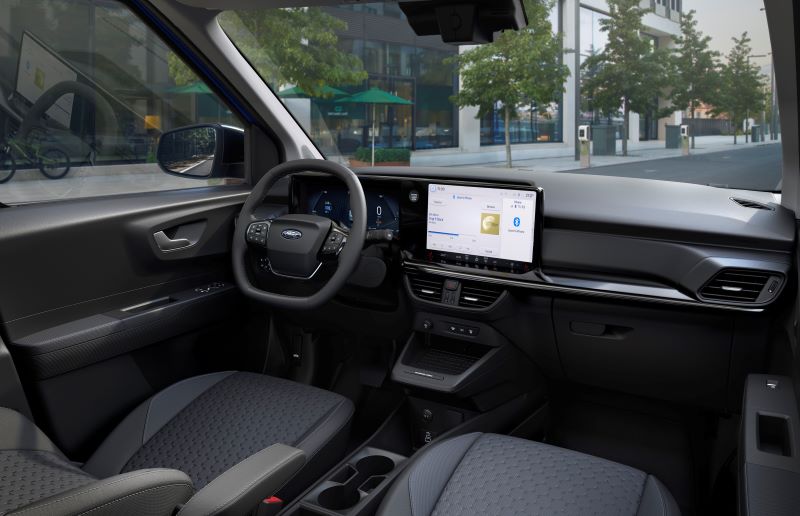
Ford E-Transit Courier: Cab & Interior
The Ford E-Transit Courier's interior is all-new, and it takes inspiration from the Custom by devoting a lot of its functionality over to a large 12-inch touchscreen.
Whereas diesel and petrol versions get more tactile buttons for the heating controls, the E-Transit Custom shifts them to a strip along the bottom of the screen.
While this may be foreign initially as you look to find the right option, it soon becomes second-nature and consolidates a screen that is easy-to-navigate and offers clear, engaging graphics that operate with little lag.
Alongside the touchscreen is another 12-inch instrument display giving you clear indication of your speed, remaining charge and shows when you’re harvesting energy back into the battery by coasting.
Even just sitting ‘behind the wheel’ is a break with conformity as the E-Transit Courier gets what Ford refers to as a ‘squircle’ steering wheel. While unusual to look at it, all you’ll notice on the move is a pleasantly thick Sensico rim that allows you to comfortably grip the wheel as your arm rests on the door, while knee room is much improved too.
While the seat back is upright, there is plenty of adjustment, while the combination of a lofty driving position and large windscreen offer excellent forward visibility.
There are also plenty of cubby spaces, including a shelf above the driver/passenger, plus a centre console than can be interchanged to house cups, papers, pens or knick-knacks.
Though the interior is sufficiently spacious for two people, there isn’t an option to specify a two-person bench alongside the driver’s seat.
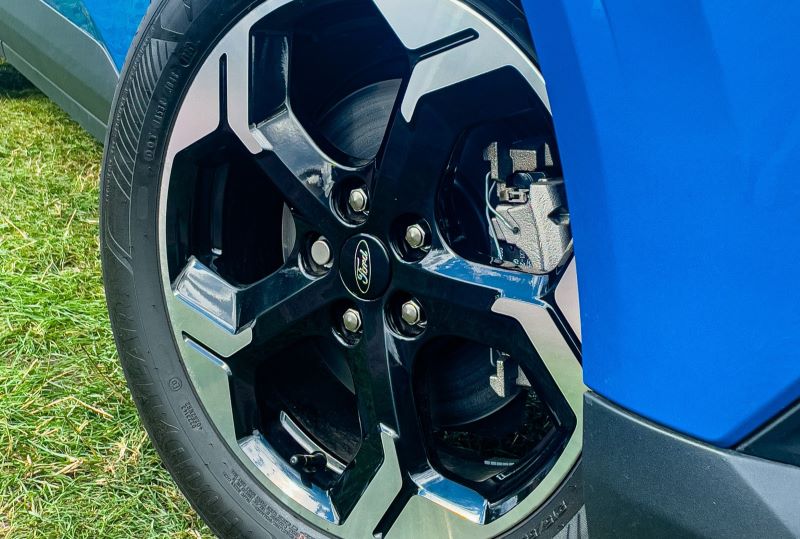
Ford E-Transit Courier: Specifications, Equipment & Trims
Two trim levels are available with the Ford E-Transit Courier – the Trend and, as tested, the flagship Limited.
Kit is generous across both trims with an emphasis on safety equipment and smart connectivity, including Ford’s own SYNC4 connected navigation with charging network information built-in, while signing up for FordPass gives you vehicle location and battery charge level straight to your phone wherever you are.
Ford E-Transit Courier Trend Standard Equipment:
- Climate control
- Front end light-bar (EV only)
- Single sliding door
- Front fog lights
- LED Daytime running lamps (EV only)
- Body-coloured bumpers
- Overhead console
- Power windows
- 12-inch touchscreen display
- Bluetooth with Apple CarPlay and Android Auto
- Steering Wheel Controls
- Six-way driver seat adjustment
- Four-way passenger seat adjustment
- ‘Frunk’ front cargo stowage
- Front and rear parking aid
- Mechanical parking brake
- Keyless start
Ford E-Transit Courier Limited Standard Equipment - all features of Trend, plus:
- Front grille with chrome spear
- Body-colour door handles
- Power adjusted and heated mirrors
- Automatic windscreen wipers
- Quick clear heated windscreen
- Heated driver and passenger seat
- Sensico-wrapped heated steering wheel
- 17-inch alloy wheels
- Digital rear view camera parking aid
- Interior wireless charging pad
Ford E-Transit Courier: Reliability
The Ford E-Transit Courier comes with a warranty that runs to 3-years or 60,000 miles from new whichever comes first.
It should be mentioned that Ford has strong reliability record with its commercial vehicles with the brand named the third most dependable manufacturer in Fleet News’ ‘FN50’ reliability survey.
Moreover, the sheer ubiquity of Ford and its commercial programme ensures there is a huge network of dealerships and service/repairs locations across the country. Our supplier here is Vertu Ford Newcastle which specialises in the sale and maintenance of Ford commercial vehicles.
Ford E-Transit Courier: Safety & Security
The Ford Transit Courier was awarded the maximum five-stars for safety by EuroNCAP.
While commercial vehicles aren’t crash tested (unlike passenger cars), they are instead rated on the volume of preventative safety features – known as Advanced Driver Assistance Systems (ADAS) – and their effectiveness in scenarios, such as a pedestrian walking out or avoiding rear-end collisions.
The Transit Courier was singled out for its large array of standard safety features – such as standard-fit autonomous emergency braking and forward-collision warning – and success in real-world test scenarios, earning it praise for its ‘all-round excellent performance’.
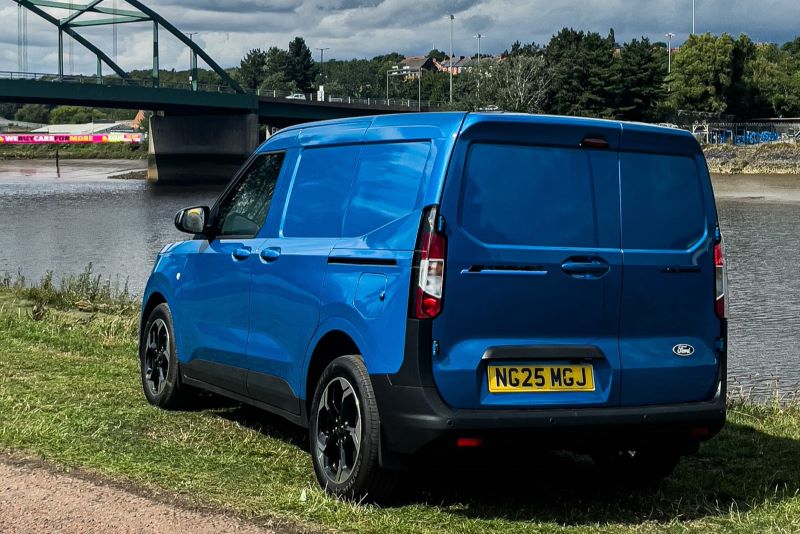
Ford E-Transit Courier: FULL VERDICT
Deciding on the Ford E-Transit Courier is likely to come down to whether you’re willing to sacrifice some cargo space and payload capability to choose it over a Citroen Berlingo or Ford’s own Transit Connect.
Indeed, a lack of direct rivals now that models like the Citroen Nemo and Renault Kangoo Express have been discontinued means the Transit Courier can’t hide its smaller dimensions compared to alternatives that sit more neatly in the small van segment.
However, some nifty design traits mean the E-Transit Courier maximises what it has to such an extent that the difference in room ends up negligible. In other words, it takes up precious little space on the road, yet some expert packaging makes it as practical and useable as you’ll likely ever need for a model of this size.
In electric guise, the E-Transit Courier holds a lot of appeal, more so considering the Connect isn’t available as a full BEV.
Range won’t be an issue if you remain within its natural city-based habitat, but you’ll still get a responsive and unexpectedly agile vehicle that feels more car-like behind the wheel than its more utilitarian rivals.
Indeed, the Puma-derived mechanicals make the E-Transit Courier a boon in town, making it the perfect delivery van, especially if your route tends to include Clean Air Zones.
It’s also brimming with ‘big car’ kit, has an excellent safety rating and – being a Ford – means you’ll never be far from a dealership.
How Does the Ford E-Transit Courier Compare To Rivals?
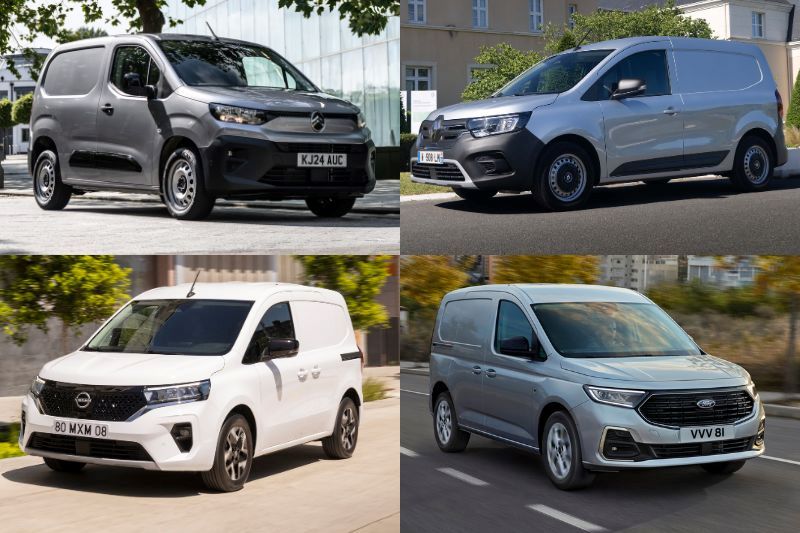
| Ford E-Transit Courier 43kWh Limited | Citroen e-Berlingo 52kWh Enterprise Plus M | Renault Kangoo E-Tech 44kWh MWB | Nissan Townstar 1.3TCe Tekna L1 | Ford Transit Connect 1.5 EcoBoost PHEV Trend | |
| Powertrain | Electric | Electric | Electric | Petrol | Plug-In Hybrid |
| Battery Capacity | 43kWh | 52kWh | 44kWh | - | 19.7kWh |
| Engine Capacity | - | - | - | 1333cc | 1498cc |
| Max Power | 134bhp | 136bhp | 120bhp | 130bhp | 150bhp |
| Max Torque | 290Nm | 270Nm | 245Nm | 240Nm | 350Nm |
| Range [WLTP Comb] | 181 miles | 213 miles | 186 miles | - | 72 miles |
| Fuel Economy [Comb] | - | - | - | 41.5mpg | 586mpg |
| CO2 [WLTP] | 0g/km | 0g/km | 0g/km | 155g/km | 11g/km |
| Recharge | 10-80% - 23mins | 0-80% - 30mins | 20-80% - 30mins | - | 5-80% - 26mins |
| Fuel Tank Capacity | - | - | - | 54 litres | 50 litres |
| Length | 4337mm | 4403mm | 4486mm | 4486mm | 4500mm |
| Height | 1850mm | 1860mm | 1864mm | 1864mm | 1856mm |
| Wheelbase | 2692mm | 2785mm | 2716mm | 2716mm | 2755mm |
| Load Length | 1802mm | 1817mm | 1810mm | 1810mm | 1797mm |
| Load Volume | 2.9 cu m | 3.3 cu m | 3.3 cu m | 3.3 cu m | 3.1 cu m |
| Max Payload | 683kg | 759kg | 615kg | 724kg | 704kg |
| Towing Capacity | 750kg | 750kg | 750kg | 1500kg | 1500kg |
| Gross Vehicle Weight | 2250kg | 2450kg | 2230kg | 2180kg | 2400kg |

















